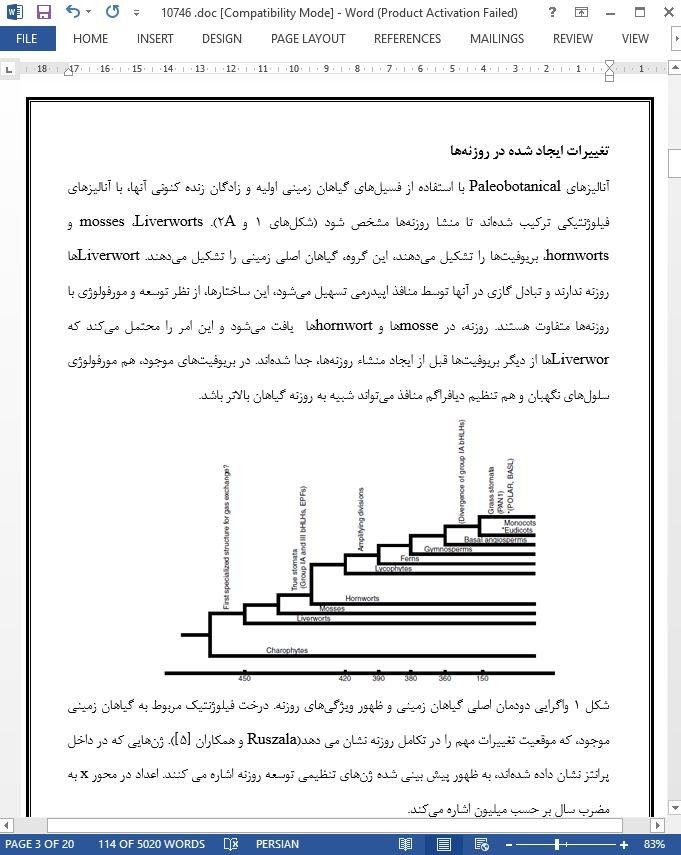
مکانیسم های توسعه روزنه: یک دیدگاه تکاملی
چکیده
توسعه گیاهی دارای دو مرحله پس رویانی مهم است که به شدت توسط برهمکنشهای بین گیاه و محیط بیرونی هدایت میشود. این برهمکنشها در توسعه، الگوبندی و عملکرد روزنهای که منافذ اپیدرمی بر روی سطوح هوایی گیاهان زمینی هستند، بسیار مشهود است. روزنهها را میتوان در فسیلهایی با قدمت بیش از 400 میلیون سال پیش مشاهده کرد. مورفولوژی پیچیده روزنههای منفرد، تا حد زیادی بدون تغییر مانده است، اما اندازه، تعداد و ترتیب روزنهها و سلول های اطراف آنها به صورت قابل توجهی تغییر کرده است. در بسیاری از گیاهان، روزنهها از اجزای تخصصی و موقت شبه سلولهای بنیادی در برگ بوجود میآیند. مطالعات انجام شده در گیاه گلدار آرابیدوپسیس thaliana، چارچوب مولکولی پایهای را برای کسب سرنوشت سلولی و ایجاد قطبیت سلولی در این اجزا ایجاد کرده است، همچنین، این مطالعات، برخی از سیگنالهای کلیدی و گیرندههای مورد نیاز برای ایجاد روزنه را در الگوهای سازمان یافته و به تعدادهایی که از نظر زیستی بهینه شدهاند، توصیف کردهاند. در این مقاله، ما آنالیزهای موازی را در مورد مسیرهای توسعه روزنه در سطح مورفولوژیکی و مولکولی ارائه و تغییرات جدیدی را که توسط کلادهای خاصی از گیاهان انجام شده است را توصیف میکنیم.
مرور
مقدمه ای بر روزنه و الگوی روزنهای
گیاهان حدود 400 میلیون سال پیش، در زمین ظاهر شدند. در فسیلهای ثبت شده، ظهور این گونههای پیشگام، همزمان با ظهور ساختارهایی بر سطح آنها بود که روزنه نام گرفت. هر روزنه، متشکل از یک جفت سلول نگهبان اپیدرمی، منافذ بین آنها و فضای هوایی در بافت فتوسنتزی مزوفیلی است که در آن قرار دارد. عملکرد روزنه، تنظیم تبادل گاز بین گیاه و محیط اطراف آن است. در بازههای زمانی کوتاه (چند دقیقه تا چند ساعت)، باز و بسته شدن منافذ روزنه توسط تغییرات فشار تورگر در شکل سلولهای نگهبان روزنه، فرآیند تنظیمی مهمی در حفظ تعادل آب و دی اکسید کربن است. مطالعات انجام شده توسط بسیاری از آزمایشگاهها، آبشارهای انتقال سیگنال داخل سلولی را توصیف کردهاند که تغییرات در اندازه منافذ را در پاسخ به هورمونها و سیگنالهای محیطی میانجیگری میکنند [1].
نتیجه گیری
توسعه روزنهها در آرابیدوپسیس، به عنوان یک سیستم ژنتیکی مدل برای تجزیه و تحلیل سرنوشت سلول، قطبیت سلولی و ارتباطات سلول به سلول استفاده می شود. ماهیت محصولات ژنی شناسایی شده در چنین بررسیهایی، همراه با ارزیابی طولانیمدت تعداد و الگوهای روزنهای در گیاهان مختلف با اهداف تاکسونومیک، باعث میشود تا این سیستم، یک آزمایشگاه طبیعی مفید برای بررسی تکامل موازی ژنها و چرخههای توسعه باشد. با افزایش تعداد گیاهانی که ژنوم آنها تکمیل میشود و همینطور ایجاد ابزارهای دستکاری آزمایشی گونههای غیر مدل، ما اعتقاد داریم که فرصت بسیار عالی برای بررسی نقش ژنهای کاندید کد کننده فاکتورهای سیگنالدهی سلولی و سرنوشت سلولی در ایجاد تنوع توسعه ای، ایجاد خواهد شد.
Abstract
Plant development has a significant postembryonic phase that is guided heavily by interactions between the plant and the outside environment. This interplay is particularly evident in the development, pattern and function of stomata, epidermal pores on the aerial surfaces of land plants. Stomata have been found in fossils dating from more than 400 million years ago. Strikingly, the morphology of the individual stomatal complex is largely unchanged, but the sizes, numbers and arrangements of stomata and their surrounding cells have diversified tremendously. In many plants, stomata arise from specialized and transient stem-cell like compartments on the leaf. Studies in the flowering plant Arabidopsis thaliana have established a basic molecular framework for the acquisition of cell fate and generation of cell polarity in these compartments, as well as describing some of the key signals and receptors required to produce stomata in organized patterns and in environmentally optimized numbers. Here we present parallel analyses of stomatal developmental pathways at morphological and molecular levels and describe the innovations made by particular clades of plants.
Review
Introduction to stomata and stomatal pattern
Plants conquered land more than 400 million years ago. In the fossil record, the appearance of these pioneer species is contemporaneous with the appearance of structures on their surfaces called stomata. Each stoma (plural, stomata) consists of paired epidermal guard cells, a pore between them and an airspace in the photosynthetic mesophyll tissue subtending it. The function of stomata is to regulate gas exchange between the plant and its surroundings. On short timescales (minutes to hours), the opening and closing of the stomatal pore by turgor-driven changes in guard cell shape is a key regulatory step in maintaining water and carbon dioxide balance. Work from many laboratories has defined the intracellular signal transduction cascades that mediate changes in pore size in response to hormone and environmental signals [1].
Conclusions
Stomatal development in Arabidopsis has been used as a model genetic system for the analysis of cell fate, cell polarity and cell to cell communication. The nature of the gene products identified in such analysis, coupled with the long tradition of evaluating the numbers and patterns of stomata in diverse plants for taxonomic purposes makes this system a useful natural laboratory to look at the parallel evolution of genes and developmental trajectories. As the number of completed plant genomes increases and tools for experimental manipulation of non-model species develop, we believe there will be an excellent opportunity to test the roles of candidate cell fate- and cell signaling factor-encoding genes in creating developmental diversity.

چکیده
مقدمه ای بر روزنه و الگوی روزنهای
تغییرات ایجاد شده در روزنهها
مسیرهای توسعه روزنه در آرابیدوپسیس
قوانین بیشتر برای روزنههای تک لپهایها
تکامل تنظیم کننده های روزنه
ژنهای bHLH روزنهای آرابیدوپسیس، در دودمانهای گیاهی تولید کننده روزنه وجود دارند
ظهور اخیر تنظیم کننده های قطبیت
تکامل باز شدن تنظیم شده منافذ روزنه
نتیجه گیری
Abstract
Introduction to stomata and stomatal pattern
Innovations
Pathways for stomatal development in Arabidopsis
Additional rules for monocot stomata
Evolution of stomatal regulators
Arabidopsis stomatal bHLH genes are in stomatal-producing plant lineages
New appearance of polarity regulators
Evolution of regulated stomatal pore opening
Conclusions
- اصل مقاله انگلیسی با فرمت ورد (word) با قابلیت ویرایش
- ترجمه فارسی مقاله با فرمت ورد (word) با قابلیت ویرایش، بدون آرم سایت ای ترجمه
- ترجمه فارسی مقاله با فرمت pdf، بدون آرم سایت ای ترجمه
